Thick descriptions
Surveilling Nature: Getting Lost on Explore.org
By Natalia Hernández Somarriba
Surely, getting lost online, in dwellings of diverse depth and too many clicks, or playing with the little human figure to view a street in a faraway city you read about in a book, is a commonplace for many these days. Wretched internet, is the media that through different technologies for better or worse, we now consider our companion. Another certainty is that for a little over a year, us human animals on a large part of the globe, have been living in extended and intermittent periods of lockdown. The pandemic caused by Covid-19 is notably more or less urgent, depending on where one lives and who one is. Since December 2019 I have been living in Europe, first Berlin, now Utrecht. Only from the privileged perspective of living the crisis in such cities is that I dare to refer to this health emergency.
Two facts then inspire this description. First, the lockdown on account of the pandemic, which as one of its consequence has caused most of human social activity to be carried out online; and for the majority of entertainment facilities (including aquatic zoos) to be indefinitely closed to the public. Second, the state of awe that the ocean and its living beings inspire in humans including myself; and our entanglement with the sea as terrestrial beings in this planet. The ocean is air, weather, food and health. We literally depend on it.
The need to submerge in the Pacific or the Atlantic is as pressing as currently impossible for me. Travel is restricted, and subject to the final destination unviable. I have not been able to go home, to the oceans, the Pacific and the Atlantic that I know and first loved. This makes my heart and other muscles in my body ache. So when I listen to Sonia Levy’s “An Ecology of Perhaps” paired with Derek Walcott’s famous line “The sea is history,” It hits me. I need to somehow go back to that sea. As close as I can get is online, via a surveillance website for non-human animals, explore.org, financed by the Annenberg Foundation.
Explore’s director is Charles Annenberg, grandson of Annenberg Foundation’s creator, who was a media tycoon and former Ambassador to the court of St. James. Charles Annenberg claims that his goal with the website is to be “the worlds largest nature network,” because they want viewers “to fall in love with the world again.” Charlie, as he calls himself in the promotional video, advertises purity as the main characteristic of his live cams, contrary to the edited quality of nature films, of which they also have a considerable archive. Explore aims to be the biggest virtual zoo, except with “no bars.” Nonetheless, most of the cameras are either in nature reserves, conservation projects, rehabilitation and rescue centers, or even within aquaria.
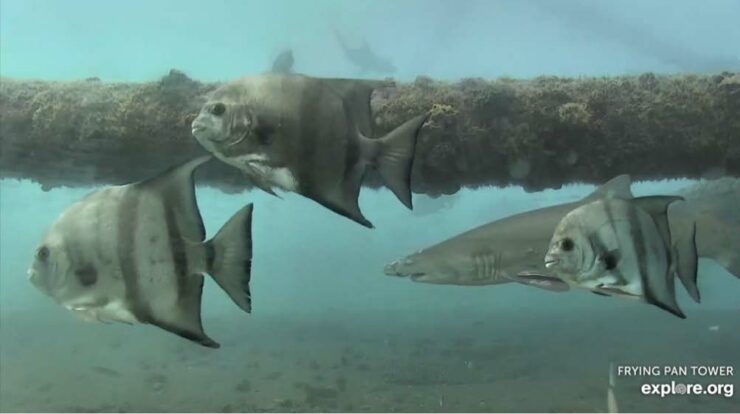
I get lost in Explore. The website has at least thirty different channels with names such as Zenscapes, Dog Bless You, or Africam. The number of live streams varies according to time difference and location. I decide to focus on the aquatic channel named “Ocean” which has a photo of a charismatic dolphin. I find Explore during a quick search about online zoological parks and aquaria. Quickly The Guardian pops up and talks about a “wave of webcam visits” to aquariums during Covid shutdown. Most of the links on the piece refer me to locations in the continental United States. I land on Explore, which is essentially everywhere. I am intrigued from the beginning, with the quantity of live streams and viewers, and the possibility to think about human observation and interactions with aquatic species, and the connections that take place with the ocean as a space.
For the purpose of this description I will focus on two streams: Sharks in the Atlantic, located in Cape Fear, North Carolina; and the Channel Islands Kelp Forest, in Anacapa Island, California. Firstly, I will examine the technology utilized both to record the animals in their spaces, as well as the user interface of the website itself; thinking about Donna Haraway’s description of technologies not as “mediations but organs, full partners” (249). Secondly, I will examine the context, regarding the animals being explored, and the conservation logic of the partner organizations involved in the camera’s locations. Thirdly, I will think about what types of contact is allowed through this technology and media, considering Eva Hayward’s sensation and hapticity, but also the effect water and biodiversity has on humans according to various studies (Cracknell et al). Lastly, I will attempt to answer what is the agency of the animal in the mediated human online community within Explore (Haraway 261).
Underwater Cams
The promise in both the Explore streams mentioned above are two, that they are live, at least for extended day-time periods. Second, that they are located strategically, that is where it is assured viewers will get the most of what the camera promises, be it sharks, or a kelp forest holding several marine species. In other words, you get your money’s (in this case time’s) worth. Not much of the technology behind the underwater black boxes is explained, as viewers we do not know what model they are, or how many times a month they are serviced. Although I did catch a diver cleaning a cam once. One can infer that cameras are programmed to be on only in the daytime, as sometimes the specific stream you tune in is dark or playing what the website names “Highlights” (edited footage of the best viewings). Another feature, of at least the Shark stream, is that a camera person sometimes drives the cameras and takes viewers on directed rides through the ocean. For instance, CamOp Kwaahu, promised on April 16 to swim with the Sharks for a couple of hours, be inconspicuous and provide good views. It must have been nice, I was not there for the trip due to time zone issues.
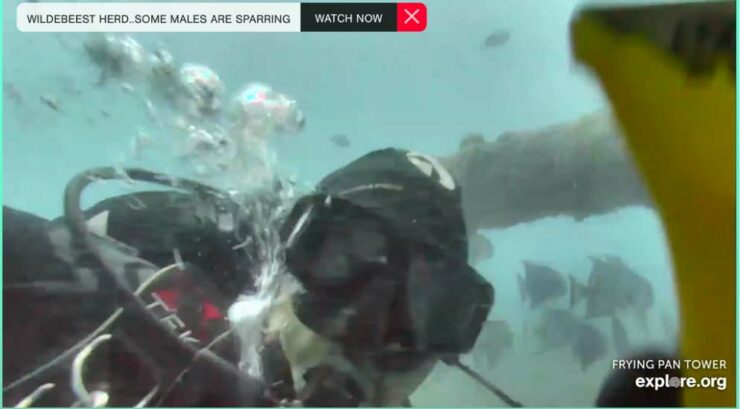
In addition, the website allows viewers, if logged in, to take snapshots of the images you get while watching, after this you may also upload and caption them. Others users will later interact and comment on each other’s shots. If you encounter an animal, and do not know their name you may ask your fellow viewers. It is a pretty active comment section, I tried it once unsuccessfully. I was watching the Shark cam, and many came up, three screenshots later I was uploading one pic commenting, “Very exciting to see them.” An hour passed by and I was politely alerted by a moderator that those where “Highlights” and not a live stream. Humiliating.
To use Haraway’s terms, what this underwater technology is infolding together with our marine friends, the water’s in/visibility, the viewers, the user interface, the sporadic camera operators, and the partners handling the reserved areas where the cameras are located, is a “composition” of things;[6] “coordinated to magnify power, to make something happen, to engage the world, to risk fleshy acts of interpretations” (250). A myriad of things are indeed happening here, most notably as a viewer I find myself immersed in the footage, in all my thirteen inches and tiny speakers, my room is suspended. I even leave it on while reading. Floating, liquid, gulping sounds. I see mostly fish: grey, purple and yellow round mouth fellows. I am unable to stop rhyming or panning my head with the camera. One very still shark shows up, this time live as I check to see it does not signal the video as Highlights. Shark sightings seem, even when live, mostly uneventful. I am thinking I would need a bigger screen and surround (Jaws theme song). Two revelations: I want to carry this water sound everywhere with me; fish both swim and swing.
Cape Fear and Anacapa Island
In every sense of the institution these channels are virtual aquatic zoos. Animals are on display, education is performed through various formats, and the waters around the cameras are safe havens for animals. Moreover, conservation logic is pivotal for both institutions, The Frying Pan Tower (Shark cam), and Channel Islands National Park (Kelp Forest cam). Words like research, protection, education, knowledge, and shelter, are used by both organizations to refer to their mission and goals regarding aquatic space and their inhabitants in relation to humans. If interested, the fish and non-fish can be looked up in guides offered by the organisation, the camera divers and moderators of the forums are more than willing to answer questions, and there are alternate streams with scientists giving lessons on aquatic life.
The reason for the camera’s location at the The Frying Pan Tower is both due to the infrastructure of this former light station, revitalized by a non-profit of the same name, and to the conditions of the water. According to the digital publication CoastWatch, sounds, estuaries and ocean waters around North Carolina are habitats sought by some sharks. Most of the sharks are transient, yet some use the sounds as a nursery and remain there for a longer time.
The Channel Islands, being part of the National Parks Service in the United States, is a protected area which includes the islands and 20% of the water surrounding them. Here is where the Kelp Forest camera is located specifically in the landing cove in Anacapa Island, where years of isolation and the mix of cold and warm waters gave rise to a rich biodiversity. I learned for instance that the fish I saw in the Kelp Forest stream is called Garibaldi, and they are protected by California state law. Garibaldis are described by the federal government of the United States as both curious and territorial.
This stream and camera were apparently down for a while, according to the comments section, and recently came online again. The live visuals are essentially an impasto painting of kelp below, blue above, rays of sun joining in to dance with the forest. Early in the morning fish seldom show up, later though I spent a good hour grabbing screenshots of Garibaldi fish and just plain staring at them and the swaying kelp. Hypnotic. These specific streams, if watched sporadically or if only watch during the so-called “Highlights,” are for me a pleasant and relaxing experience. The Channel Islands Park also has a live educational stream where you can get lessons on biodiversity, see the animals grabbed by the diver for show, and learn about threats to the environment that these protected areas face. Such as plastic pollution, boating and sometimes fishing. In one show the diver actually finds a plastic toy shark, and gives a lesson on how much plastic is frequently found underwater.
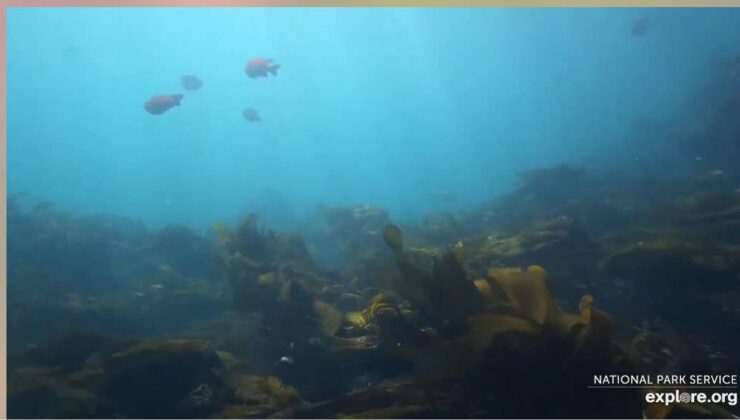
The general website of Explore.org, however, is another story. When you enter the main page, it can be a voyeuristic shock. Why in the world would someone watch sleeping flying foxes, eagles, or a sheep barn, is beyond my skills to determine. I must confess though, I fully understand the need for the puppy and kitten rescue streams. This platform seems to be an entanglement between individual human pleasure from watching animals, the outside institutions’ needs for visibility and funding, and the logic of conservation that has been used to justify parks and now websites like this since the twentieth century.
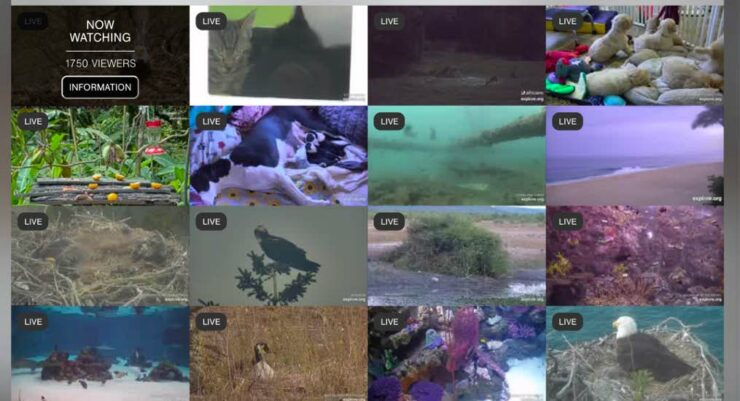
As Lisa Uddin explains in the introduction to her book Zoo Renewal, the “bad zoo feelings” that John Berger pointed at in “Why Look at Animals”, occurred in a time (1960s and 1970s) when zoos in the west started to embrace a logic of renewal (2), to “simulate natural habitats” for animals, as well as to promote the “restoring of animals populations at home and abroad” (3). It is not possible then to explain this online platform in a cause and effect logic, since like most zoological gardens it is a paradox. Adorno, said it best: “The more purely nature is preserved and transplanted by civilisation, the more implacably it is dominated” (115).
Touchy-Feely
In “Captivating”, chapter one of her book SymbioSeas, Eva Hayward studies the sensations that “the aquarium evokes” and the “haptically charged experience” it delivers through as series of photographies by Diane Cook and Len Jenshel of different aquariums in California (4). Because of the medium she is reading, Hayward speaks of vision and texture. In my case it is film, so the sensory analysis could be closer to Laura Mark’s Haptic Criticism[10], a bottom up approach that allows art to generate theory rather than use theory to explain art. Haptic Criticism “offers a method of sensory analysis” not relying on the presence of literal senses (touch, smell, taste or hearing), but on “the affective solicitation of these senses” (qtd. in Hayward 8). The liquid sound and dancing kelp. Catnip infused anxiety reduction of peaceful looking fish. Sleepy water take me away.
This affective solicitation of the senses, this general feeling of being near, what we refer to as nature, has been studied. Evidence seems to suggests that humans value the stimulation of natural settings in general, including images of such spaces, because of positive psychological effects (Cracknell et al 447). In summary, several studies have proved that the element water is beneficial, restorative, and sought by humans. Cracknell et al. also provide an overview of diverse research focusing on the role of aquaria and biodiversity in human health and well-being.
While it is known that aquaria at homes or in clinical settings has proved to decrease anxiety, lower blood pressure, and foster social interaction among humans; less has been investigated about the relation between human health and biodiversity of animals in public aquaria. Findings range from, more attention payed in public aquaria settings stocked with higher amount of marine life, to participants reporting “feeling better”, and “more relaxed” after observing any type of aquatic exhibit. To that aquaria goers are biased towards “charismatic” species such as sharks, seahorses, jellyfish, as well as colourful tropical exhibits (Cracknell et all 452).
The Shark cam at Explore does usually have far more viewers than the Kelp cam, even if the Kelp forest is supposed to have abundance and biodiversity. The charismatic shark factor here wins. I prefer the Kelp, although I must admit I mildly enjoy spotting sharks, and whenever I see any bright red Garibaldi or yellow-blue Angelfish I say hi to them. In conclusion, I am an average participant of the research featured by Cracknell et all. I become a bit obsessed with the Garibaldis, and will probably let the water sound on while reading more often after this scientific confirmation. Maybe I will even go to one of the many aquaria in the Netherlands as soon they are open.
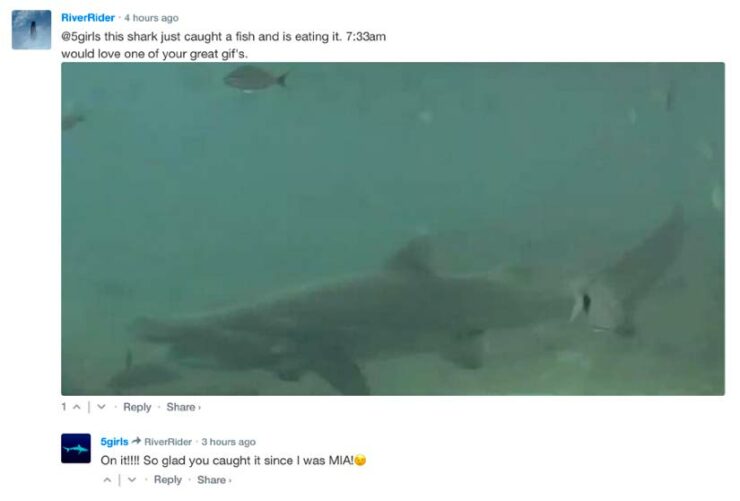
Pop Comments
Explore provides a separate internet forum for each stream. A small community of viewers, camera operators, and moderators, gather to share photos, name animals, and engage in conversation. They share slow motion video clips of harbour seals, occurrences among cubbyu, and admire the swaying kelp. It is unclear to me how the human viewing is taking place. I wonder how many tabs they have open at the same time. Do they keep their screenshots in a separate folder or on their desktop? (mine is crowded with fish by now, and I must organize it soon). Are among the users of Explore, persons with disabilities, who perhaps are unable to go to the ocean? More importantly, what is going on with the marine animals? The cameras do not seem to affect them more than the divers visiting, they appear to be going about their days “normally,” and having a decent life. They are just being watched by us, and this, to say the least is a rather quirky habit.
How is this, “animal-human-technology hermeneutic relation” infolding? (Haraway 262). Maybe the animals have more power in the relationship than us viewers, as the animals may not show up, and we will be disappointed. We will even complain in the comments section. The animals may stand still, remain concealed or far away. The animals may be doing far more interesting things outside the frame. The sharks will continue on their way, the garibaldis will hide beneath the kelp, or swim to other camera-less islands. Even the camera could act, it can be foggy, break, or just be shut down. The divers, that is the humans at the stations, control the cameras, provide us with bits of knowledge and may or may not take us on watching trips with them. We, the viewers, could stop watching, stop staring into screens, yet we choose not to. We choose to remain “close” and at the same time to stress the difference between us and them.
Works cited
Adorno, Theodor. Minima Moralia: Reflections from Damaged Life. Translated by E.F.N. Jephcott. London: Verso, 2005.
Cracknell, Deborah L. et al. “Reviewing the Role of Aquaria as Restorative Settings: How Subaquatic Diversity in Public Aquaria Can Influence Preferences, and Human Health and Well-Being,” Human Dimensions of Wildlife 23:5 (2018): 446-460.
Explore.org, “Sharks in the Atlantic”, https://explore.org/livecams/oceans/shark-cam.
Explore.org, “Channel Islands Kelp Forest,” https://explore.org/livecams/oceans/channel-islands-national-park-anacapa-ocean.
Haraway, Donna J. When Species Meet. Minneapolis: University of Minnesota Press, 2007.
Hayward, Eva. “Captivating.” Unpublished manuscript.
Uddin, Lisa. Zoo Renewal: White Flight and the Animal Ghetto. Minneapolis: University of Minnesota Press, 2015.

